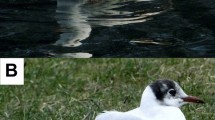Abstract
We studied Polythore damselflies by mark-recapture techniques in the Jatun Sacha Biological Reserve (Ecuador) for a period of 48 days in October–December 2014. Three species were found: Polythore mutata (MacLachlan) was the commonest species (111 individuals marked), Polythore derivata (MacLachlan) was rare (24 individuals) and Polythore concinna (MacLachlan) occasional (four individuals). In P. mutata, we found two phenotypes amongst females, one of them with a white band on the wings, very similar in colouration to the conspecific male (androchrome), and the other with an amber band (gynochrome). The recapture of marked females indicates that both phenotypes are maintained since emergence to maturation and are not age-related (i.e. polymorphism). Androchromes represent 40% of females observed. The colour of the wing band showed an age-dependent change in size with opposite trends between sexes, increasing in males and decreasing in females. Males and females were observed to return to the same forest locations in different days. Courtships and ovipositions involving androchrome females were not observed. No matings were observed in any morph. In contrast, we recorded two consecutive matings of one female P. derivata. We found that Polythore males grasp the mesothorax of females during mating instead of the prothorax as in other Zygoptera. We discuss the rarity of reproductive behaviour in this genus and how female morphs might be maintained.




Similar content being viewed by others
References
Altamiranda-Saavedra M, Palacino-Rodríguez F, Lobo-Hernández M (2014) Daily abundance at the breeding site and reproductive behavior of Polythore gigantea (Odonata: Polythoridae). Odonatologica 43:169–182
Beccaloni GW (1997) Ecology, natural history and behaviour of Ithomine butterflies and their mimics in Ecuador (Lepidoptera: Nymphalidae: Ithomiinae). Trop Lepid 8:103–124
Bick GH, Bick JC (1978) The significance of wing clapping in Zygoptera. Odonatologica 7:5–9
Bick GH, Bick JC (1986) The genus Polythore exclusive of the Picta group (Zygoptera: Polithoridae). Odonatologica 15:245–273
Burmeister EG, Börzsöny L (2003) Polythore spaeteri, spec. nov. from the Peruvian tropical rainforest (Panguana), with remarks on its ecology. Spixiana 26:43–48
Cook LM, Riley AM, Woiwod IP (2002) Melanic frequencies in three species of moths in post industrial Britain. Biol J Linn Soc 75:475–482. doi:10.1046/j.1095-8312.2002.00035.x
Corbet PS (1999) Dragonflies. Behaviour and ecology of Odonata. Harley Books, Essex
Cordero A, Andrés JA (1996) Colour polymorphism in odonates: females that mimic males? J Br Dragonfly Soc 12:50–60
Cordero-Rivera A, Andrés JA (2002) Male coercion and convenience polyandry in a calopterygid damselfly. J Insect Sci 2:14
Córdoba-Aguilar A (2002) Wing pigmentation in territorial male damselflies, Calopteryx haemorrhoidalis: a possible relation to sexual selection. Anim Behav 63:759–766. doi:10.1006/anbe.2001.1974
Fincke OM, Jödicke R, Dennis R et al (2005) The evolution and frequency of female color morphs in Holarctic Odonata: why are male-like females typically the minority? Int J Odonatol 8:183–202. doi:10.1080/13887890.2005.9748252
Fraser FC (1946) Notes on Amazonian Odonata in the Leeds Museum. R Entomol Soc Lond 96:11–47
Fraser AM, Herman TB (1993) Territorial and reproductive behaviour in a sympatric species complex of the neotropical damselfly Cora Selys (Zygoptera: Polythoridae). Odonatologica 22:411–429
Grether GF (1996) Intrasexual competition alone favors a sexually dimorphic ornament in the rubyspot damselfly Hetaerina americana. Evolution (N Y) 50:1949–1957
Guillermo-Ferreira R, Neiss UG, Hamada N, Bispo PC (2014) Behavior of the Amazonian damselfly Chalcopteryx scintillans McLachlan (Zygoptera: Polythoridae) and comments on its morphological distinction from C. rutilans (Rambur). Int J Odonatol 17:251–258. doi:10.1080/13887890.2014.983189
Hooper RE, Plaistow SJ, Tsubaki Y (2006) Signal function of wing colour in a polymorphic damselfly, Mnais costalis Selys (Zygoptera: Calopterygidae). Odonatologica 35:15–22
Miller PL, Miller CA (1981) Field observations on copulatory behaviour in Zygoptera, with an examination of the structure and activity of male genitalia. Odonatologica 10:201–218
R Core Team (2016) R: a language and environment for statistical computing. R Foundation for Statistical Computing, Vienna, Austria. http://www.r-project.org
Sánchez-Herrera M, Realpe E (2010) Population structure of Polythore procera at a Colombian stream (Odonata: Polythoridae). Int J Odonatol 13:27–37. doi:10.1080/13887890.2010.9748358
Sánchez-Herrera M, Kuhn WR, Lorenzo-Carballa MO et al (2015) Mixed signals? Morphological and molecular evidence suggest a color polymorphism in some neotropical Polythore damselflies. PLoS One 10:1–24. doi:10.1371/journal.pone.0125074
Siva-Jothy MT (1999) Male wing pigmentation may affect reproductive success via female choice in a calopterygid damselfly (Zygoptera). Behaviour 136:1365–1377. doi:10.1163/156853999500776
Stewart AJA, Lees DR (1996) The colour/pattern polymorphism of Philaenus spumarius (L.) (Homoptera: Cercopidae) in England and Wales. Philos Trans R Soc Lond B Biol Sci 351:69–89
Van Gossum H, Sherratt TN, Cordero-Rivera A (2008) The evolution of sex-limited colour polymorphisms. In: Córdoba-Aguilar A (ed) Dragonflies: model organisms for ecological and evolutionary studies. Oxford University Press, Oxford, pp 219–229
Waage KJ (1973) Reproductive behavior and its relation to territoriality in Calopteryx maculata (Beauvois) (Odonata: Calopterygidae). Behaviour 47:240–256
Yu X, Bu W (2011) A description of the remarkable larva of Pseudolestes mirabilis Kirby (Odonata: Pseudolestidae). Int J Odonatol 14:105–110
Acknowledgments
Special thanks to Cornelio Bota-Sierra, Melissa Sánchez-Herrera and José Martín Meléndez-Quinto for sharing with us their observations of copulation in Polythore and some pictures. We are also grateful to Alejandro Suárez (director of the reserve) and to the Jatun Sacha staff for the support during our stay, especially to Nixon Stalin Andi for his help in the maintenance and observation of the collected logs after our trip. Andrea Encalada helped with paperwork and logistics. Austin Kent Moore improved our English. We also acknowledge comments of two anonymous reviewers. ISV was supported by a FPI grant of the Ministry of Economy and Competitiveness of the Spanish Government (BES-2012-052005). This research was founded by projects CGL2011-22629 and CGL2014-53140-P from the Spanish Ministry with competences in science to ACR, including European Fund for Regional Development (FEDER).
Author information
Authors and Affiliations
Corresponding author
Additional information
Edited by Ranyse B Querino – Embrapa
Electronic supplementary material
Below is the link to the electronic supplementary material.
Rights and permissions
About this article
Cite this article
Sanmartín-Villar, I., Cordero-Rivera, A. Female Colour Polymorphism and Unique Reproductive Behaviour in Polythore Damselflies (Zygoptera: Polythoridae). Neotrop Entomol 45, 658–664 (2016). https://doi.org/10.1007/s13744-016-0417-7
Received:
Accepted:
Published:
Issue Date:
DOI: https://doi.org/10.1007/s13744-016-0417-7




